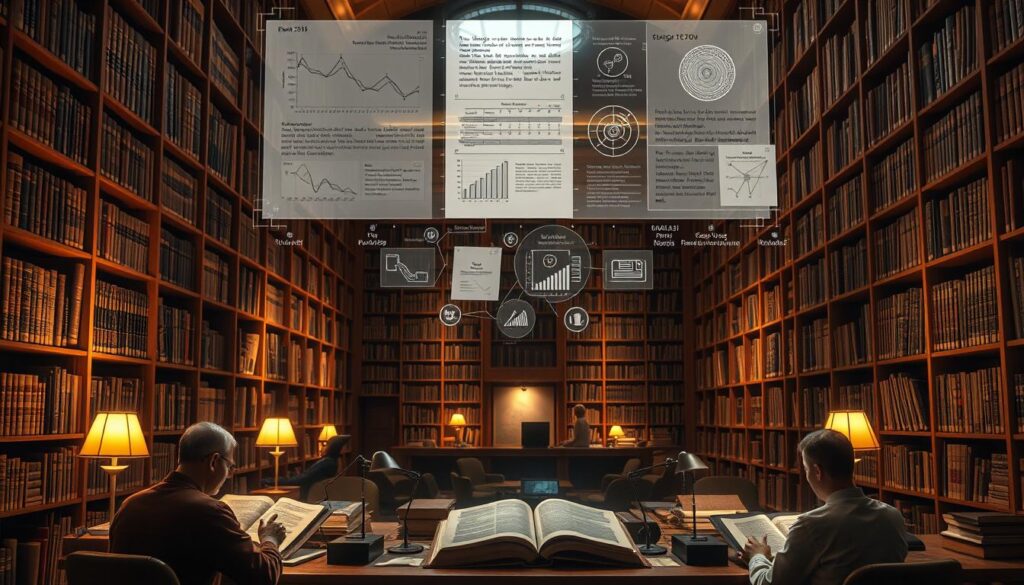Over 5 billion people today follow traditions shaped by writings older than the Great Wall of China. These ancient works, passed down through generations, remain cornerstones of faith, law, and identity worldwide.
From the poetic hymns of the Rigveda (composed 1500-1000 BCE) to meticulously preserved Quranic manuscripts, sacred writings blend oral storytelling with written precision. The Codex Vaticanus, one of Christianity’s oldest Bibles, shows how languages like Greek and Hebrew became vessels for spiritual ideas.
These collections don’t just belong to temples or museums. They influence modern ethics, art, and even legal systems. For example, the Talmud’s commentaries still guide Jewish life, while Buddhist Tripitaka scrolls shape mindfulness practices.
Why do these texts endure? They adapt. Stories once memorized by firelight evolved into printed books, yet their core messages resonate across borders. This article explores how ten pivotal works continue to inspire societies—proving wisdom has no expiration date.
Introduction to Religious Texts
Foundational documents of faith shape beliefs and cultures worldwide. These works, often called scriptures, hold sacred authority for communities. Scholars define scripture as writings believed to convey divine truth, distinct from other theological works.
The term originates from Latin scriptura, meaning “a writing.” As expert Peter Beal notes, early Christians used this word specifically for texts seen as God-inspired. This distinction remains vital when examining compilations like the Old Testament and New Testament.
While the Old Testament forms Judaism’s core, both Testaments guide Christian practice. Debates continue about which writings belong in official canons. Translation accuracy proves crucial—a single mistranslated phrase can alter doctrinal understanding.
Academic research helps unravel these complexities. Through analyzing ancient manuscripts, experts uncover how sacred writings influenced legal systems and moral codes. Their work bridges ancient wisdom with modern interpretation.
A Journey Through Ancient Origins
Civilizations carved their deepest truths into stone and memory long before paper existed. The oldest known sacred writings emerged in Mesopotamia and Egypt, where stories of gods and mortality took shape. The Pyramid Texts (2400-2300 BCE) reveal Egyptian beliefs about the afterlife, while the Epic of Gilgamesh explored human longing for immortality through clay tablets.

India’s Vedic tradition preserved wisdom through song. The Bhagavad Gita, part of the Mahabharata epic, began as oral teachings around 500 BCE. Its dialogues between prince Arjuna and Krishna were later inscribed on palm leaves, blending philosophy with warrior ethics.
| Region | Key Text | Oral Period | Written Transition |
|---|---|---|---|
| Mesopotamia | Epic of Gilgamesh | 2100 BCE | 7th c. BCE |
| Egypt | Pyramid Texts | 2400 BCE | 2nd c. BCE |
| India | Bhagavad Gita | 500 BCE | 2nd c. CE |
| Judea | Hebrew Bible | 1200 BCE | 2nd c. BCE |
By the 2nd century BCE, scribes began codifying spoken traditions. The Hebrew Bible transitioned from scrolls to bound manuscripts during this era. Errors crept in as languages evolved—Aramaic translations of Hebrew scriptures sometimes altered meanings unintentionally.
Early translators faced dilemmas: stay literal or adapt for clarity? These choices still impact how modern readers engage with ancient works. From stone carvings to digital scrolls, humanity’s quest to preserve sacred ideas continues bridging past and present.
Canonical, Non-Canonical, and Extracanonical Debate
What makes a book sacred? For centuries, communities have wrestled with this question through heated debates about canon—the official list of writings considered divinely inspired. Three categories define these discussions:
- Canonical: Texts fully accepted as authoritative
- Non-canonical: Works explicitly rejected
- Extracanonical: Writings existing outside approved lists
The history of canon formation reveals stark differences across world religions. Early Christian councils like the Synod of Laodicea (364 CE) banned certain books, while others gained approval through majority vote. These decisions still echo today:
| Tradition | Canonical Books | Apocrypha Status | Key Council |
|---|---|---|---|
| Protestant | 66 | Rejected | Westminster (1647) |
| Catholic | 73 | Deuterocanonical | Trent (1546) |
| Orthodox | 78 | Accepted | Jerusalem (1672) |
Ethiopian Christians include Enoch in their Bible—a text others deem extracanonical. Such variations fuel modern interfaith dialogues. When Mormon leaders added the Book of Abraham to their canon in 1880, it sparked new theological directions.
Religious authorities continue shaping these boundaries. Their choices determine which writings guide worship practices and ethical frameworks worldwide. As digital archives make rare texts accessible, old debates gain fresh urgency in our interconnected world.
Diverse Sacred Traditions in World Religions
Sacred writings mirror the kaleidoscope of human experience across continents and eras. Each religion preserves wisdom through distinct literary forms—from poetic hymns to legal codes—that shape cultural identities and societal norms.

Five major religions demonstrate this variety. Hinduism’s Vedas, composed in rhythmic Sanskrit, guide rituals and philosophical inquiry. The Quran in Islam provides Arabic verses governing worship and civic law. Jewish scholars debate the Talmud‘s commentaries to apply ancient principles to modern life.
Christianity’s Bible blends narrative and epistles, while Buddhist Sutras capture dialogues about ending suffering. These works aren’t just spiritual manuals—they’re blueprints for daily living. The Analects of Confucianism, though non-theistic, similarly outline ethical conduct for harmonious societies.
| Tradition | Core Text | Life Influence | Legal Role |
|---|---|---|---|
| Hinduism | Vedas | Ritual practices | Caste system guidelines |
| Islam | Quran | Daily prayers | Sharia principles |
| Judaism | Talmud | Dietary laws | Civil dispute resolution |
Each scripture represents a unique form of engagement with the divine. Some use parables; others present direct commandments. This diversity reflects how communities interpret transcendent truths through cultural lenses.
Understanding these works remains a vital part of global literacy. They reveal how societies balance tradition with progress, offering timeless insights into human values. From marriage customs to economic ethics, sacred writings continue shaping worldviews in visible and subtle ways.
Religious Texts: Transmission, Translation, and Transformation
Sacred writings have traveled through centuries by voice, pen, and press, shaping civilizations along their path. Early communities relied on memory and ritual to preserve their core beliefs. Hindu Vedic hymns passed through 3,000 years of oral tradition before being inscribed on palm leaves.

- Skilled reciters memorizing entire works
- Scribes copying manuscripts with ritual precision
- Scholars cross-checking versions for errors
The 1440 printing press revolutionized access to sacred literature. Gutenberg’s Bible became Europe’s first mass-produced book, spreading ideas faster than ever. But translation introduced new topics of debate. Arabic terms in the Quran’s 114 chapters often lose poetic nuance when rendered into English.
Consider these translation challenges:
- Sanskrit’s layered meanings in the Bhagavad Gita
- Hebrew idioms in Psalms that confuse modern readers
- Greek philosophical concepts in New Testament letters
The Prophet Muhammad’s teachings show how time transforms works. His revelations became the Quran, while his daily sayings were compiled later as Hadith. Scholars still debate which Hadith accurately reflect his words, proving how transmission methods shape authority.
Modern editions differ from ancient manuscripts in subtle ways. A 10th-century Hebrew Bible fragment might use alternate spellings compared to today’s versions. These variations remind us that sacred literature remains a living conversation between past and present.
The Authority of Religious Texts Across Cultures
Communities worldwide anchor their deepest values in revered writings through deliberate practices. A sacred text gains authority when its words shape laws, inspire art, and guide daily choices. Three key factors reinforce this power:
- Ritual recitations during worship
- Generational storytelling traditions
- Scholarly preservation of original meanings
In the 8th century, Quranic scribes developed precise calligraphy rules to honor divine messages. Their manuscripts became visual art and spiritual guides. Similarly, Hindu priests still chant Vedas using ancient tones passed through 100 generations.
Liturgical hymns in prayer books show how repetition breeds reverence. Christian monks copied psalms into illuminated manuscripts, blending written book with sacred performance. These practices transform words into lived experiences.
Authority also depends on context. Buddhist sutras gained influence in China through local storytelling styles. Meanwhile, Jewish scholars cross-referenced 12th-century commentaries to maintain Torah accuracy.
Modern experts use digital tools to preserve delicate scrolls. Their work ensures critical information survives for future seekers. From courtroom oaths to bedtime stories, sacred writings remain society’s moral compass through active engagement.
Modern Interpretations and Critical Analyses
Scholars now use advanced tools to unravel layers of meaning in ancient scriptures. Digital archives and linguistic software help compare thousands of manuscript variations. These methods reveal how cultural shifts shaped interpretations over time.

Recent debates focus on balancing tradition with fresh perspectives. For example, some theologians reinterpret Genesis creation stories as metaphorical narratives about human purpose. Others analyze Paul’s letters through first-century social norms rather than modern ethics.
| Approach | Traditional View | Modern Analysis |
|---|---|---|
| Language Study | Literal translation | Contextual meaning |
| Ethical Guidance | Fixed rules | Cultural adaptation |
| Historical Context | Divine timeline | Sociopolitical factors |
Digital tools let researchers track word usage across 50+ Quran translations instantly. This reveals how terms like “jihad” evolved from spiritual struggle to political concepts. Such findings challenge rigid authority claims while respecting core belief systems.
Modern scholars often create dynamic equivalence translations that capture original intent rather than word-for-word accuracy. The New Revised Standard Version Bible (2021) uses gender-inclusive language where ancient language allowed it. These updates spark discussions about preserving heritage while addressing contemporary needs.
Through global collaboration, experts compile lists of disputed passages for interfaith dialogue. Their work helps others see sacred writings as living documents—anchored in history yet open to new understandings.
Conclusion
From scrolls to screens, sacred writings bridge millennia of human experience. These works evolved from oral chants to printed books, yet their core messages still shape societies. Debates over translations and canonical lists persist, but their cultural influence remains undeniable.
Modern readers uncover fresh insights in age-old works. The New Testament’s parables gain new depth through historical context, while the Tao Ching offers adaptable wisdom for today’s fast-paced world. Scholars now decode layered meanings using digital tools, proving ancient guidance remains relevant.
Every generation reinvents how it engages with these treasures. Whether studying the New Testament’s ethical frameworks or the Tao Ching’s balance principles, people find personal connections. Translation challenges and canon disputes fade beside their enduring power to inspire action.
Explore these works yourself. Let the New Testament’s hope or the Tao Ching’s simplicity spark reflection. Their teachings—preserved through wars and technological shifts—still help us navigate life’s complexities. True wisdom, it seems, never goes out of style.

